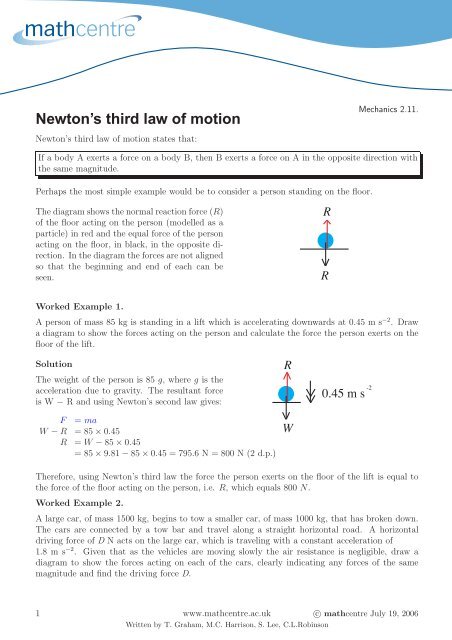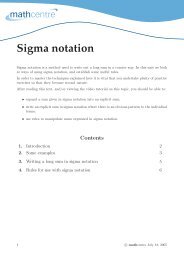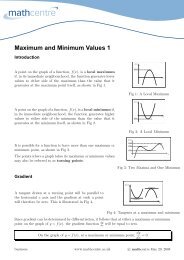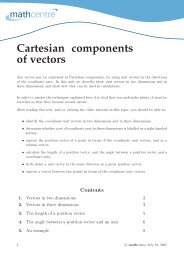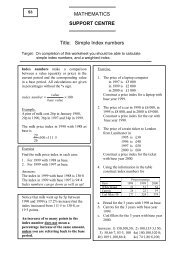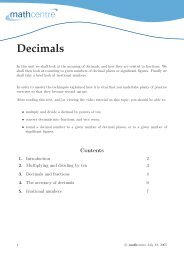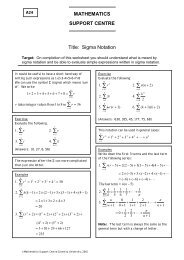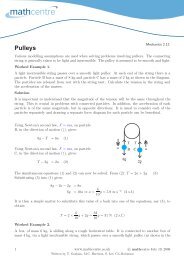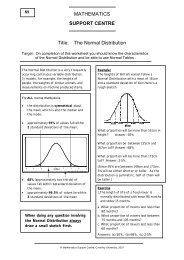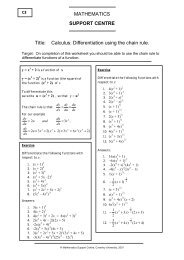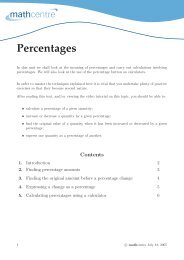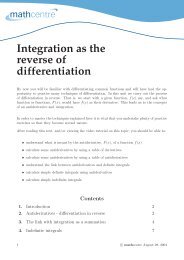Newton's third law of motion
Newton's third law of motion
Newton's third law of motion
Create successful ePaper yourself
Turn your PDF publications into a flip-book with our unique Google optimized e-Paper software.
Newton’s <strong>third</strong> <strong>law</strong> <strong>of</strong> <strong>motion</strong><br />
Newton’s <strong>third</strong> <strong>law</strong> <strong>of</strong> <strong>motion</strong> states that:<br />
Mechanics 2.11.<br />
If a body A exerts a force on a body B, then B exerts a force on A in the opposite direction with<br />
the same magnitude.<br />
Perhaps the most simple example would be to consider a person standing on the floor.<br />
The diagram shows the normal reaction force (R)<br />
<strong>of</strong> the floor acting on the person (modelled as a<br />
particle) in red and the equal force <strong>of</strong> the person<br />
acting on the floor, in black, in the opposite direction.<br />
In the diagram the forces are not aligned<br />
so that the beginning and end <strong>of</strong> each can be<br />
seen.<br />
R<br />
R<br />
Worked Example 1.<br />
A person <strong>of</strong> mass 85 kg is standing in a lift which is accelerating downwards at 0.45 m s −2 . Draw<br />
a diagram to show the forces acting on the person and calculate the force the person exerts on the<br />
floor <strong>of</strong> the lift.<br />
Solution<br />
The weight <strong>of</strong> the person is 85 g, where g is the<br />
acceleration due to gravity. The resultant force<br />
is W − R and using Newton’s second <strong>law</strong> gives:<br />
F = ma<br />
W − R = 85 × 0.45<br />
R = W − 85 × 0.45<br />
= 85 × 9.81 − 85 × 0.45 = 795.6 N = 800 N (2 d.p.)<br />
R<br />
W<br />
0.45 m s -2<br />
Therefore, using Newton’s <strong>third</strong> <strong>law</strong> the force the person exerts on the floor <strong>of</strong> the lift is equal to<br />
the force <strong>of</strong> the floor acting on the person, i.e. R, which equals 800 N.<br />
Worked Example 2.<br />
A large car, <strong>of</strong> mass 1500 kg, begins to tow a smaller car, <strong>of</strong> mass 1000 kg, that has broken down.<br />
The cars are connected by a tow bar and travel along a straight horizontal road. A horizontal<br />
driving force <strong>of</strong> D N acts on the large car, which is traveling with a constant acceleration <strong>of</strong><br />
1.8 m s −2 . Given that as the vehicles are moving slowly the air resistance is negligible, draw a<br />
diagram to show the forces acting on each <strong>of</strong> the cars, clearly indicating any forces <strong>of</strong> the same<br />
magnitude and find the driving force D.<br />
1 www.mathcentre.ac.uk c○ mathcentre July 19, 2006<br />
Written by T. Graham, M.C. Harrison, S. Lee, C.L.Robinson
Solution<br />
As can be seen in the diagram, Newton’s <strong>third</strong><br />
<strong>law</strong> applies in the tow bar, with respect to the<br />
tension T. It also applies between the ground and<br />
each car.<br />
R1<br />
T<br />
T<br />
R2<br />
1.8 m s -2<br />
D<br />
F = ma<br />
D = 2500 × 1.8<br />
D = 4500 N<br />
(2 d.p.)<br />
1000g<br />
1500g<br />
Exercises<br />
1. A person <strong>of</strong> mass 94 kg is standing in a lift which is accelerating upwards at 0.54 m s −2 . Draw<br />
a diagram to show the forces acting on the person and calculate the force, F, the person exerts<br />
on the floor <strong>of</strong> the lift.<br />
2. A person <strong>of</strong> mass 65 kg is standing in a lift <strong>of</strong> mass 400 kg, which is accelerating upwards at<br />
0.6 m s −2 . Draw a diagram to show the forces acting on the lift and calculate their respective<br />
values.<br />
3. An engine, <strong>of</strong> mass 3500 kg, tows two carriages, each <strong>of</strong> mass 600 kg on a set <strong>of</strong> straight<br />
horizontal rails. Given that the engine has a horizontal driving force <strong>of</strong> D N and that as they<br />
are moving slowly the air resistance is negligible, draw a diagram to show the forces acting<br />
on the engine and both carriages, clearly indicating any forces <strong>of</strong> the same magnitude.<br />
4. A tug boat, <strong>of</strong> mass 8000 kg, is towing a smaller boat, <strong>of</strong> mass 2000 kg. Given that the tug<br />
boat has a horizontal driving force <strong>of</strong> D N and that they are accelerating at 1.2 m s −2 , draw<br />
a diagram to show the forces acting on both boats and calculate the driving force<br />
Answers (All to 2 s.f.)<br />
1.<br />
R = 970 N = F<br />
2.<br />
T = 4800 N<br />
0.54 m s -2<br />
0.6 m s -2<br />
W = 920 N<br />
W = 3900 N<br />
R = 680 N<br />
3.<br />
R1<br />
T1<br />
T1<br />
R1<br />
T2<br />
T2<br />
R2<br />
D<br />
4.<br />
F1<br />
T<br />
T<br />
F2<br />
1.2 m s -2<br />
D = 12000 N<br />
600g<br />
600g<br />
3500g<br />
2000g<br />
8000g<br />
2 www.mathcentre.ac.uk c○ mathcentre July 19, 2006<br />
Written by T. Graham, M.C. Harrison, S. Lee, C.L.Robinson


